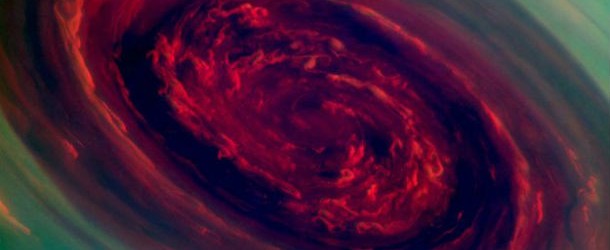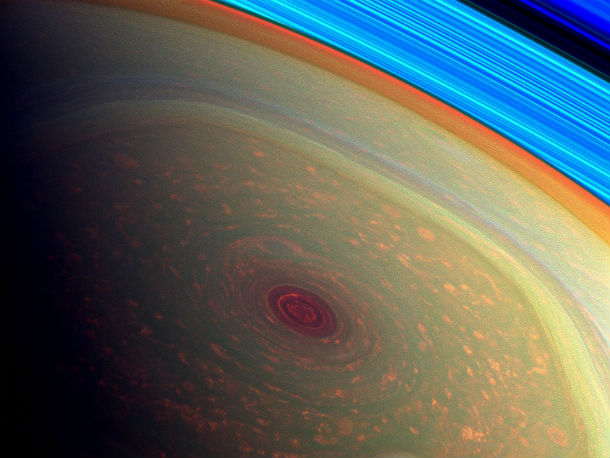Massive hurricane-like storm on Saturn

The international Cassini spacecraft has found a behemoth hurricane swirling around Saturn’s north pole, surrounded by the curious rotating hexagonal band of clouds. This storm has been churning since at least 2006.
The images Cassini took on November 27, 2012 from a distance of 418 000 – 419 000 km, provided scientists the first close-up, visible-light views of this storm. NASA’s Voyager 2 spacecraft did not have a clear view of this area of Saturn’s north pole when it passed by in 1981, but it did detect and observe the hexagonal band of clouds that is so wide that it could fit almost four Earths inside.
In high-resolution pictures and video, the hurricane’s eye is about 1,250 miles (2,000 kilometers) wide, 20 times bigger than what an average hurricane eye on Earth usually is. Thin, bright clouds at the outer edge of the hurricane are traveling 330 mph (540 km/h or 150 meters per second). The eyewall winds are blowing more than four times faster than hurricane winds on Earth.The hurricane spins around inside a huge, mysterious, six-sided weather pattern known as the hexagon.

Experts will be studying the hurricane to acquire new insight into hurricanes on Earth, which feed off warm ocean water. Since there is no body of water near these clouds in Saturn’s atmosphere, getting to know how these Saturnian storms make use of water vapor could tell scientists more on how terrestrial hurricanes are generated and sustained.
Saturn’s hurricane looks very similar to those we see on Earth, although it is much larger and faster.
Both Earth’s hurricane and Saturn’s north polar vortex have an eye in center with no clouds or very low clouds. Some other similar features are high clouds forming an eye wall, also other high clouds spiraling around the eye, and a counter-clockwise spin in the northern hemisphere.


This spectacular, vertigo inducing, false-color image from NASA’s Cassini mission highlights the storms at Saturn’s north pole. The angry eye of a hurricane-like storm appears dark red while the fast-moving hexagonal jet stream framing it is a yellowish green. Low-lying clouds circling inside the hexagonal feature appear as muted orange color. A second, smaller vortex pops out in teal at the lower right of the image. The rings of Saturn appear in vivid blue at the top right. The images were taken with Cassini’s wide-angle camera using a combination of spectral filters sensitive to wavelengths of near-infrared light. The images filtered at 890 nanometers are projected as blue. The images filtered at 728 nanometers are projected as green, and images filtered at 752 nanometers are projected as red. At Saturn, this scheme means colors correlate to different altitudes in the planet’s polar atmosphere: red indicates deep, while green shows clouds that are higher in altitude. High clouds are typically associated with locations of intense upwelling in a storm. These images help scientists learn the distribution and frequencies of such storms. The rings are bright blue in this color scheme because there is no methane gas between the ring particles and the camera. The view was acquired at a distance of approximately 261,000 miles (419,000 kilometers) from Saturn and at a sun-Saturn-spacecraft, or phase, angle of 94 degrees. Image scale is 13 miles (22 kilometers) per pixel. The Cassini-Huygens mission is a cooperative project of NASA, the European Space Agency and the Italian Space Agency. The Jet Propulsion Laboratory, a division of the California Institute of Technology in Pasadena, manages the mission for NASA’s Science Mission Directorate, Washington, D.C. The Cassini orbiter and its two onboard cameras were designed, developed and assembled at JPL. The imaging operations center is based at the Space Science Institute in Boulder, Colorado.
(Image Credit: NASA/JPL-Caltech/SSI)
But some remarkable differences must be noted. As mentioned, the main difference between the hurricanes is that the one on Saturn is much larger than its counterparts on Earth and spins amazingly fast. Also at Saturn, the wind in the eye wall blows approximately four times faster than hurricane-force winds on Earth. Furthermore, terrestrial hurricanes have a tendency to move, where the Saturnian hurricane is anchored onto the planet’s north pole. On Earth, hurricanes tend to drift northward under the influence of forces acting on the fast swirls of wind as the planet rotates. Unlike the one on Saturn that doesn’t move and is already as far north as it can be.
The polar hurricane has nowhere else to go, and that’s likely why it’s stuck at the pole, explained Kunio Sayanagi, a Cassini imaging team associate at Hampton University in Hampton, US.


Researchers believe the massive Saturnian hurricane has been churning for years. At the time Cassini spacecraft arrived in the Saturn system in 2004, Saturn’s north pole was covered in darkness because the planet was in the middle of its north polar winter. During that period, the Cassini spacecraft’s composite infrared spectrometer and visual and infrared mapping spectrometer detected a large vortex, but to get a visible-light view scientists had to wait for the passing of the equinox in August 2009. Only then did sunlight begin to lighten up Saturn’s northern hemisphere. A change in the angle of Cassini’s orbits around Saturn was required so the spacecraft could see the poles.
According to Scott Edgington, Cassini deputy project scientist at NASA’s Jet Propulsion Laboratory in Pasadena, California, such a stunning and mesmerizing view of the hurricane-like storm at the north pole is only possible because Cassini is on a sportier course, with orbits tilted to loop the spacecraft above and below Saturn’s equatorial plane. He said you cannot see the polar regions very well from an equatorial orbit. Observing the planet from different vantage points reveals more about the cloud layers that cover the entirety of the planet, he concluded.
For more information about Cassini and its mission, visit: http://www.nasa.gov/cassini and http://saturn.jpl.nasa.gov .
Featured image: The first close-up views of the Saturn’s storm captured by Cassini from a distance of about 419 000 km from Saturn on 27 November 27, 2012. Image scale is 2 kilometres per pixel.(Credit: NASA/JPL-Caltech/SSI)

Fascinating!!! As do most earthly hurricanes, can tornadic activity also occur within these Saturn mega-storms? If so, have these also been captured on film? Thank You!